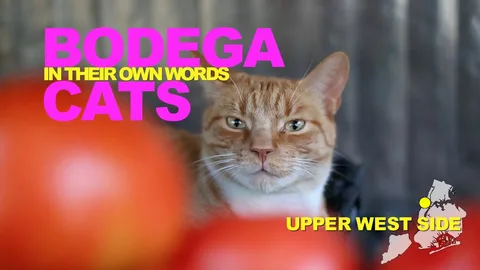Introduction
In the huge, New York’s Bodega Cats throbbing environment of New York City, where millions of humans navigate through sprawling skyscrapers, subway tunnels, and congested sidewalks, there is one unlikely creature that has become all but mythical: the bodega cat.
These tattered, street-smart felines are more than pets—they’re protectors, friends, and de facto mascots of the city’s favorite corner bodegas. Stretching from Bushwick to the Bronx, the bodega cat is as integral a New York icon as the yellow cab, the hot dog cart, or the shrill cry of the subway.
What Is a Bodega
Before we go into the lives of these cats, we need to know their territory.
A bodega is a tiny convenience store located on nearly every other block in New York City. Derived from the Spanish term for “storeroom” or “wine cellar,” bodegas were originally owned by Puerto Rican and other Latin American immigrants. Over time, the term came to symbolize the classic NYC corner store—carrying everything from snacks and cigarettes to toilet paper, cat food, and even a good sandwich.
Bodegas are not merely shops;
they are local institutions. Some are open 24/7, serving as lifelines to residents who depend upon them for day-to-day essentials. And reigning supreme in this environment is the bodega cat.

The Emergence of the Bodega Cat
Bodega cats began appearing out of necessity. Small businesses, in a rodent-infested city, couldn’t keep up with pest control. Not always affordable or effective to hire exterminators or continuously restock traps, Enter: the cat.
Cats are natural predators, and the mere presence of them is enough to scare off mice and rats. But over time, these cats did more than simply keep vermin at bay—they became institutions in their neighborhoods, adored by store owners and customers alike.
The average bodega cat is a rescue—stray, abandoned, or feral cats that store owners take in and provide with shelter, food, and an unlimited amount of attention.
Life in the Aisles
Life as a bodega cat is anything but normal. They prowl up and down the cramped aisles of densely crowded shelves, ride on top of the ATM machine, or sleep on stacks of soda cases. Their lives are usually determined by the movement of customers, their human family’s habits, and the patches of sunlight on the floor.
Certain cats are reserved and elusive, sneaking away from new guests. Others are fearless and social, wrapping themselves around legs, meowing for a snack, or even swiping at your sandwich. Every cat has a unique personality—some aloof, some playful, all unmistakably charming.
In spite of the city’s tumult, these cats radiate serenity, nearly meditative energy. They’re both vigilant and laid-back, like furry guards at the gates of New York’s daily routine.
Internet Fame and Meme Culture
In the digital age, bodega cats have become icons.
These posts blend humor and affection, often with captions that anthropomorphize the cats as store managers, philosophers, or New York’s most overworked employees.
In a city where everyone’s always rushing, there’s something grounding about a cat taking a nap in the middle of a chaotic bodega. Their nonchalance becomes a tiny rebellion against the hustle.
Legality and Controversy
As beloved as bodega cats are, their existence isn’t entirely without controversy.
According to the New York City Department of Health, animals are not allowed in establishments that sell food. Technically, having a cat in a bodega is a health code violation that can result in fines. However, enforcement is rare, and most health inspectors turn a blind eye unless there’s a complaint.
The irony isn’t lost on many New Yorkers: a rodent infestation will certainly earn a fine, but so will keeping the very thing that helps prevent it.
Most locals agree—the risk of a cat hair in your sandwich is far more tolerable than a rat scurrying across your feet.
Cultural Significance and Symbolism
Bodega cats have moved beyond being pest control. They represent something more profound about New York City—its grit, its charm, and its rough-around-the-edges, yet endearing nature.
They are representative of the city’s ethos of resilience, survival, and community. Like the bodegas they call home, these cats are embedded in the city’s cultural landscape. They make people stop, smile, and engage in a city where personal space and quiet are in short supply.
They’re also reminders of home for many immigrants and working-class New Yorkers. In a city that can feel anonymous and overwhelming, the cat in your local bodega knows you. You’ve scratched its chin, maybe named it, maybe brought it a treat.
Notable Bodega Cats
Some bodega cats have achieved local celebrity status. Here are a few standout examples:
Star the Cat (Brooklyn): A white-and-gray tabby known for chilling on a cash register in Williamsburg. Locals swear Star knows when someone’s about to overpay and will paw at the register accordingly.
Lex the Manager (Harlem): A tough-looking black cat who “patrols” the front of his bodega, glaring down late-night partygoers and sleeping on top of the Doritos.
Mochi (Lower East Side): A friendly calico who’s had her own tip jar and multiple write-ups in local blogs.

A Quiet Revolution
In a way, bodega cats are silent revolutionaries. They defy regulation, scoff at conventional rules of space and cleanliness, and exist purely on terms negotiated through mutual need and affection.
They’re part of a slow, soft resistance to the corporatization of the city. As chain convenience stores try to edge out mom-and-pop shops, the bodega cat is a living reminder of individuality, authenticity, and heart.
There are no cats in CVS. But in your corner bodega, there might be a furry friend waiting to greet you.
